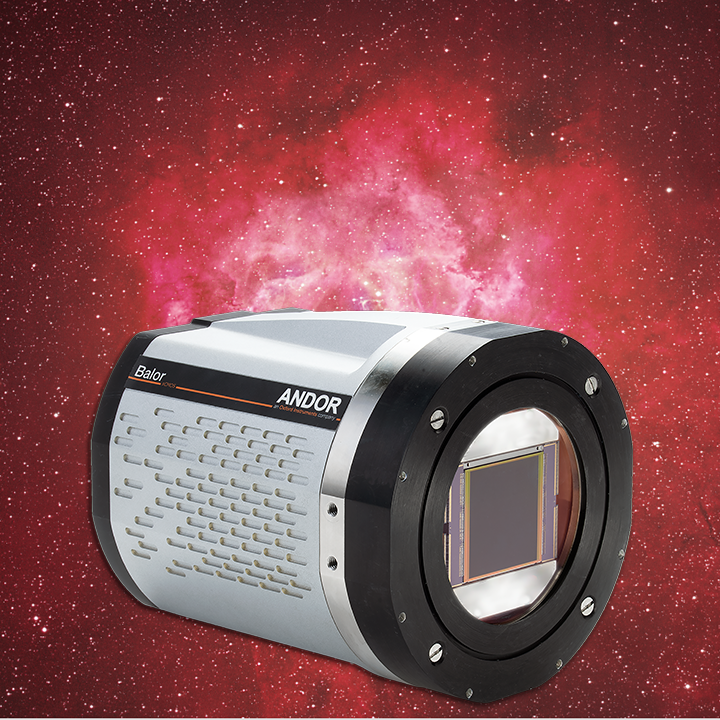3 Sep
Andor Launches Balor Camera for Astronomy
Combining Very Large Field of View with Fast, Low Noise Readout

Andor Technology (Andor), an Oxford Instruments company and world leader in scientific imaging and spectroscopy solutions, today announced the launch of the new ultra-sensitive Balor, a very large area sCMOS camera for ground-based astronomy applications. Combining a 16.9 Megapixel, 70mm sensor with fast ultra-low noise readout, Balor is the perfect detector solution for large sky surveys that measure photometric and astrometric variability across timescales ranging from milliseconds to tens of seconds. As the largest commercially available sCMOS camera, Balor is designed for ‘dynamic astronomy’ applications such as Orbital Debris tracking, Solar Astronomy, Solar System Object detection, Exoplanet Discovery, Atmospheric Studies and Fast Time Resolution Astrophysics.
Balor combines 2.9 e- read noise with an exceptionally fast 18.5 millisecond readout, allowing up to 54fps full frame readout which is perfect for studying solar or atmospheric dynamics. Quantum Efficiency is optimized for broad response across the visible-red-NIR range, with no etaloning effects, outperforming in the area of quantitative photometric measurement. The large 12 µm pixels offer an 80,000 electron well depth and an on-chip multi-amplifier design means the whole photometric range, from noise floor to saturation limit, can be captured with a single image. The wide dynamic range is complemented by enhanced on-head intelligence to deliver market-leading linearity of > 99.7%, for unparalleled quantitative accuracy of measurement across the full signal range. Such capability is ideal for photometric accuracy of light curve measurement across high dynamic range object fields.
Minimizing down-time in astronomy is paramount; not only does Balor avoid the need for a mechanical shutter, Andor is the only camera manufacturer with capability to apply an innovative hermetically sealed, permanent vacuum enclosure design to the sCMOS sensor technology. This uniquely protects the delicate sensor from attack by moisture and other gas contaminants, thus preserving both QE and stable cooling performance year after year, removing the need to have the camera re-pumped.
Balor delivers both Rolling Shutter and Global (Snapshot) Shutter exposure modes, with the latter being used for applications where every pixel across the array must carry the same relative exposure timing correlation, relative to an external timestamp.
Dr Colin Coates, Product Manager, said; “Many challenges in modern astronomy require not only high resolution, large field of view and superb sensitivity - they also require faster measurement rates. However, large area CCD technology is very much performance-limited in this regard, typically requiring more than 40 seconds to read out a single frame. The new Balor sCMOS platform addresses this fundamental application shortfall, reading out 2,500 times faster than CCDs. Balor’s frame rate is ideal for solar astronomy, capable of imaging entire sun-spots with high spatial resolution while measuring fast solar dynamics. The faster readout capability also renders Balor superb for exoplanet discovery, radically compressing measurement cycle times and allowing more time to instead be spent capturing scarce photons.”
Dr Ines Juvan-Beaulieu, author of the Exploring New Worlds blog, and Andor’s Astronomy Specialist, said; “As well as offering enhanced sensitivity and dynamic range, the large sensor area will help our ground-based astronomy customers to perform photometry and astrometry across larger areas of sky, ideal for improved statistics of detection when tracking solar system objects - imaged directly or via occultations. Balor lends itself particularly well to the technique of Lucky/Speckle Imaging, enabling resolution enhancement of ground-based astronomy over a much larger field of view than is readily achievable through use of adaptive optics.”
For more information, please visit www.andor.com/balor

